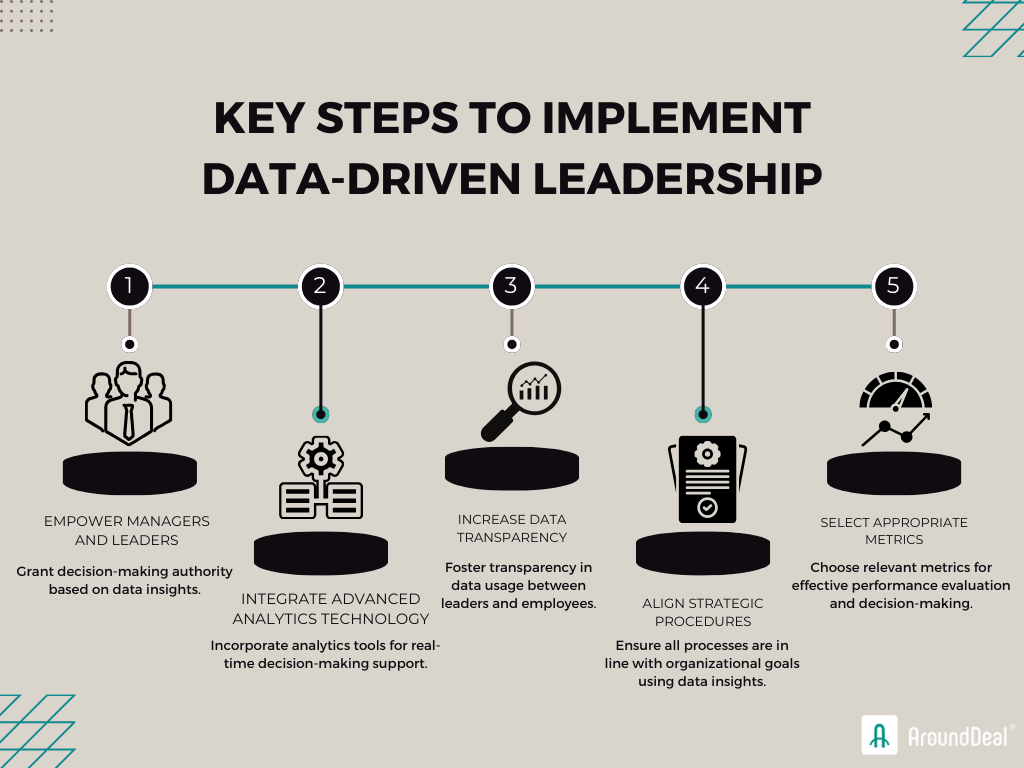- Blog /
- apac-market-insights
Data-Driven Leadership: Key to Achieving Sales Success
05 Feb 2024
By AroundDeal

Data-driven leadership is becoming more and more popular as a result of its ability to suit the needs of a wide range of organizations. Data-driven leadership is a comprehensive strategy that seeks to lead the company and workforce using real-time and accurate data and analytics.
In this leadership style, a leader makes decisions based only on acquired and analyzed data in order to match all activities with the company's overall goals and objectives. According to a report by IBM, 82% of surveyed enterprises are inhibited by data silos. Data-driven leaders can use data to identify the root causes of silos and to develop strategies to overcome them.
Throughout this article, we will discuss recent insights into data-driven leadership, the benefits of data-driven leadership, the metrics to gauge success, and the steps to implementing data-driven leadership.
Benefits of Data-Driven Leadership
An effective data-driven leadership strategy helps companies achieve their goals through efficient decision-making and the creation of a good culture. Find out how having a data-driven leader on your team can benefit you:
Informed Decision-Making through Data
In uncertain times, leaders can rely on data to guide their decisions. Data analysis enables them to transform challenges into opportunities and improve operational efficiency. Although intuition remains valuable, data allows us to gain a different perspective that improves the quality of our decisions.
Data-Driven Agility and Efficiency
Nowadays, businesses operate in a fast-paced environment that requires agility. By leveraging data-driven insights, leaders can foster team agility and improve decision-making. A vibrant data culture requires breaking down data silos and ensuring accessible, well-governed data.
Mastering Uncertainty with Data
Data-driven leaders effectively navigate the 'unknown’ of business, from geopolitical changes to environmental factors. They use data to weigh options, model scenarios, and create resilient strategies. This approach not only helps in advancing organizational goals but also inspires innovation and competitive advantage.
Key Steps to Implement Data-Driven Leadership
An organization's strategic approach to data-driven leadership begins with giving managers and leaders the authority to make decisions based on data. As part of this change, we will be using advanced analytics technology, improving data transparency at all levels, establishing strategic procedures that are in line with corporate objectives, and monitoring performance using appropriate metrics.
By adhering to five essential guidelines, businesses may build a data-driven culture that improves decision-making and promotes operational excellence.

Start With Your Managers And Leaders
Your company management strategy is dependent on the involvement and growth of your managers and leaders; thus, you must convince them to lead using data-driven leadership. This may be accomplished by strengthening leadership abilities, gathering data, using cutting-edge technology, educating employees, and improving decision-making processes based on performance results.
Improve Data Transparency
To create a healthy workplace culture and data-driven leadership, you must increase openness between your leaders and workers. However, to secure the company's precious privacy from any threats, you must include data security in your development approach.
Set Up Your Strategic Process
The primary purpose of data-driven leadership is to align the leader's efforts with your goals and objectives. As a result, your data-driven process must be well organized in order to assist you in achieving the necessary objectives and guiding each employee's function in the most effective manner possible in all organizational areas.
Therefore, a well-organized and strategically planned data-driven process is critical. The process involves identifying clear, smart objectives and collecting relevant data, such as sales figures and customer feedback. The data is then analyzed using statistical tools to identify patterns and trends. These insights guide decision-making, potentially leading to adjustments in strategies, processes, or operations.
Measuring Using Metrics
Whether we're talking about data-driven leadership approach metrics or data collection and analytics, all are critical to empowering your decision-making and creating the greatest work culture based on your skills and resources. However, you must first understand metrics in order to choose them appropriately.
A practical application of this is choosing a hosting service, where leaders must analyze various metrics such as cost, reliability, and scalability. An insightful resource for leaders is a comparative analysis of cheap VPS hosting services.
Use Analytics Technology
To have successful data-driven leadership, you must monitor and analyze acquired data using the most recent analytics technology, software, and tools to get accurate and real-world findings that may help you make better decisions. Furthermore, you should give a training program for your staff to encourage them to utilize each tool successfully, drive outcomes, cultivate a positive mentality, and remain motivated to reach the mentioned work objectives.
How Do I Choose Data-Driven Metrics?
There is no generic instructional metrics guide to follow for all organizations; instead, use appropriate metrics defined by your leader for each company and project based on the following relevant points:
Set Goals
The first step in data-driven leadership is to have a clear, measurable goal. These objectives are those that you seek to accomplish in your organization. They may be aligned with revenue growth, enhancing customer satisfaction, or introducing a new product to the market. The aims should be smart – specific, measurable, achievable, relevant, and time-bound. This clarity keeps leaders focused on their efforts and improves the odds of success.
Align Gathered Data with Your Objectives
Data-driven leadership is a type of decision-making that is based on data. After defining your objectives, the next move is to align the data collected with your objectives. This includes interpreting the data in relation to your objectives.
For instance, if you want to raise revenue, you may check the data on sales, customer’s purchasing habits, and current market trends. As a result, leaders can learn, identify successes and failures, and avoid bias when implementing intelligent solutions.
Communicate Effectively
Communication is important in data-driven leadership. It encompasses making your goals clear and the key performance indicators used in tracking the achievement of the goals. It also entails providing every stakeholder with information about the progress of the projects, any changes in the strategy, and their respective role and responsibilities. This open and direct communication gives a culture of transparency and accountability that is essential to data-driven leadership.
Final Words
Data-driven leadership is a major step in terms of management with its focus on decision-making, which is based exactly on correct and real-time data. This strategy, which is emphasized by IBM’s observations regarding the effect of data silos, equips leaders with the ability to make conscious decisions that accord with organizational objectives. Important advantages encompass better decision-making, higher agility of operations, and adapting to complicated business situations.
Data-driven leadership should be aimed at equipping the managers with analytics tools, encouraging data transparency, aligning the strategies processes with the company goals, and using the measures correctly. Ultimately, data-driven leadership creates an environment that values data as a strategic asset and drives operational excellence innovation in the current dynamic business environment.
AI Report:

Plagiarism Report:






